Male Sage Thrashers perform what is called the “Bilateral Wing Display” during courtship and territory establishment. Yesterday morning I was able to photograph the behavior on Antelope Island and though I wish I’d been a little closer I had decent light, a pretty good view of the bird and he performed for me for several minutes so I shouldn’t complain.
Just prior to the wing display the male makes a short flight (up to 10 consecutive times) in undulating circles low over the sagebrush and singing all the while before landing. These short flights are part of the courtship behavior and are called “undulating flights”.
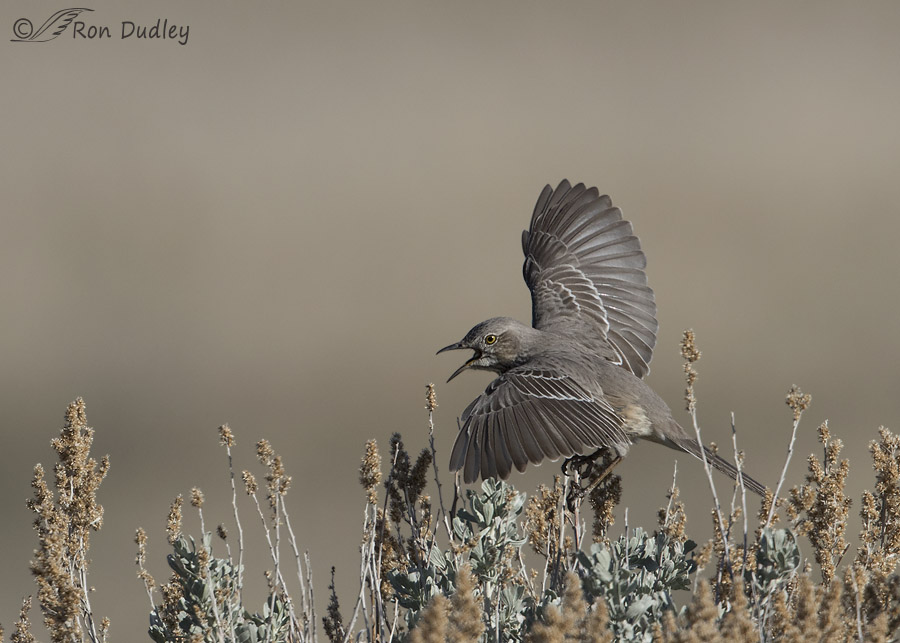
1/2500, f/7.1, ISO 500, Canon 7D, Canon EF500mm f/4L IS II USM +1.4 tc, not baited, set up or called in
When he lands on the sagebrush after the flight he raises one or both wings and flutters them while continuing to sing and this part of the performance is what’s called the Bilateral Wing Display. Here the bird has raised both wings, one higher than the other, and is singing enthusiastically.
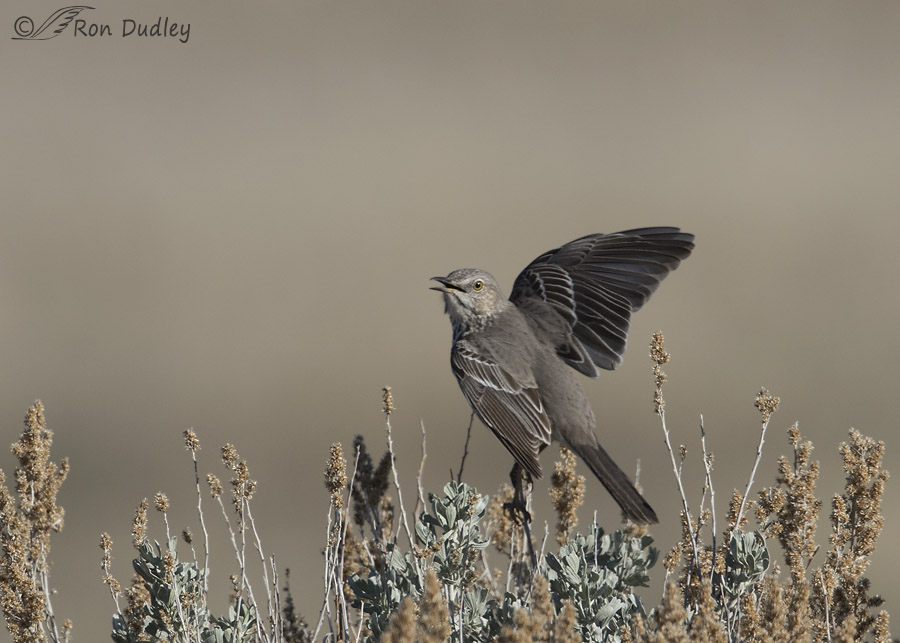
1/2500, f/7.1, ISO 500, Canon 7D, Canon EF500mm f/4L IS II USM +1.4 tc, not baited, set up or called in
Sometimes during the behavior only a single wing is raised but he continues to sing.
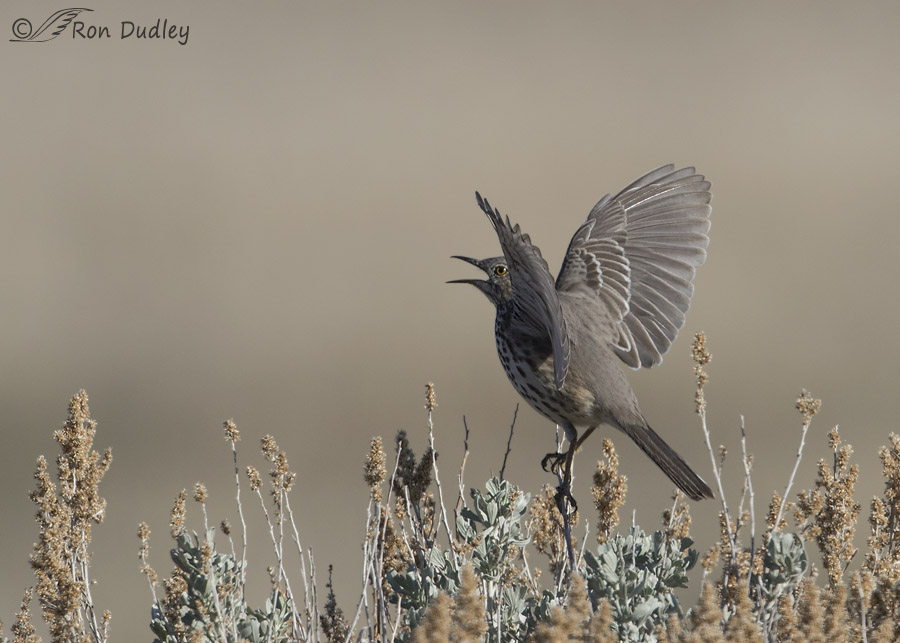
1/2500, f/7.1, ISO 500, Canon 7D, Canon EF500mm f/4L IS II USM +1.4 tc, not baited, set up or called in
At times both wings are raised equally…
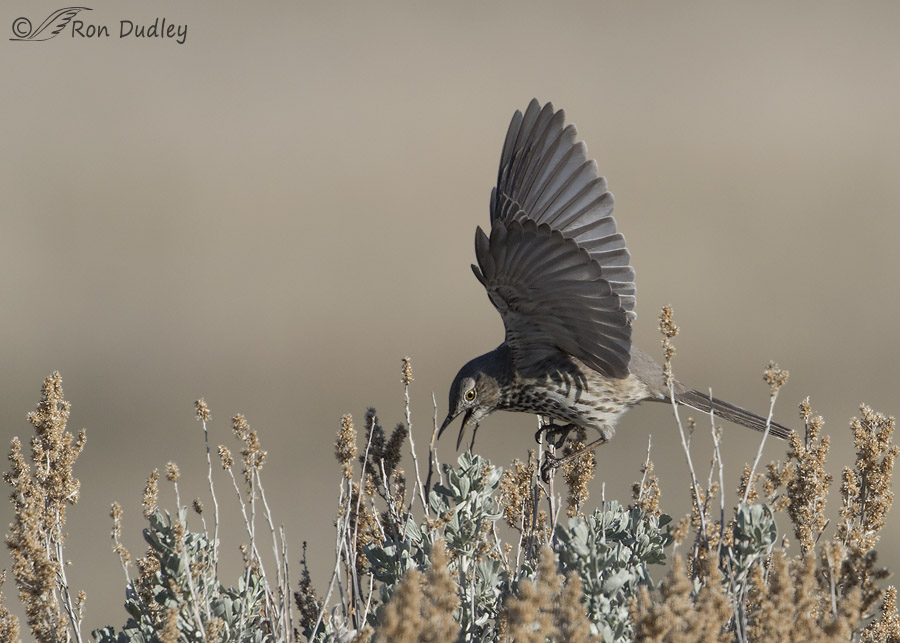
1/2500, f/7.1, ISO 500, Canon 7D, Canon EF500mm f/4L IS II USM +1.4 tc, not baited, set up or called in
and occasionally he bows his head during the process. Usually when he did this his head was in shade but this time I was able to get some light on the face.
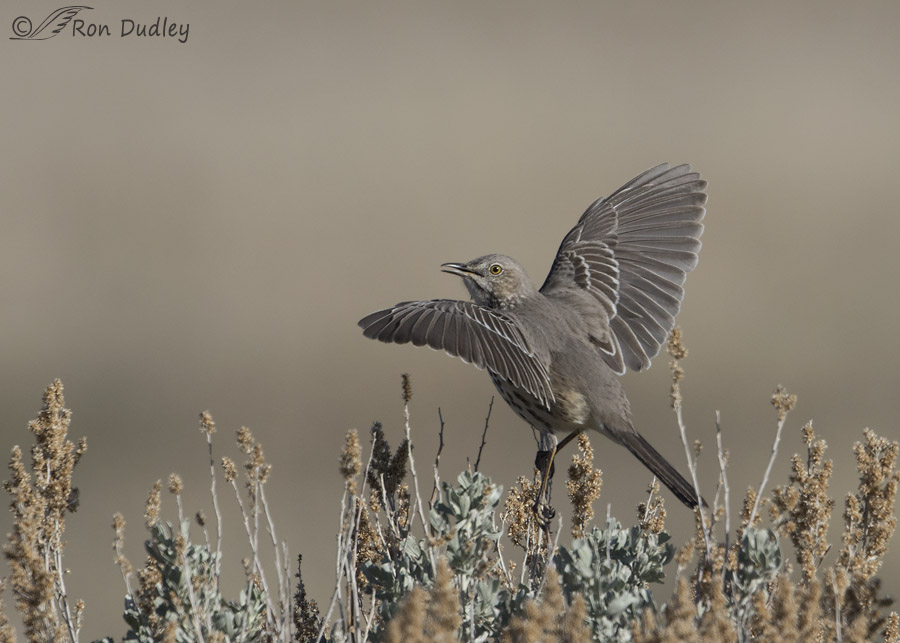
1/2500, f/7.1, ISO 500, Canon 7D, Canon EF500mm f/4L IS II USM +1.4 tc, not baited, set up or called in
He spent quite a bit of time with his back to me during the display but in this shot he looked back at me and I like the pose. These two behaviors cease at nest-building and egg-laying which strongly suggests their role in courtship but some researchers believe they may also play a role in territory establishment and maintenance.
Whatever their precise purpose I was delighted to observe both behaviors and photograph the wing display. You can bet I’ll be trying to get a little closer before the behaviors are over for the season.
Ron
PS – Spring has sprung on the island! Yesterday morning I saw my first of year Long-billed Curlews (two in flight), American Avocets (two flocks of over 100 birds total) and Tree Swallows and even watched a male Northern Harrier “sky dancing” in his attempts to entice a female. Got my photographic juices flowing…


What a great series. I imagine their song is lovely.
oh lovely, lovely!!!!!
Ron, great documentation of spring bird behavior that you posted on the vernal equinox. You captured the enthusiasm of the singing bird. Thanks
This is great to see-excited about the upcoming season and all it brings.
Just got a chance to check back & found the 2 sites you listed, Ron!! LOVED them both – thanks so much!! I’ll keep their song in my head now when I look at the photo series above!
What a privilege to see and hear.
And, on the hearing front, one of my cats is still hunting for the bird that I obviously smuggled in to his house…
Ha, I love confounding cats, EC. I can imagine the scene in my mind. I hope your feline isn’t confused for too long…
What a wondefful, melodious song! Sounds like pure, clear, sparking water bubbling up from some mountain spring!!!….Makes me happy just to hear it!!!
Ron, once again a superb melding of photographic excellence, behavior documentation and education! Amazing patience and skill (okay, maybe a smidgen of luck, too) resulting in a mind-blowing sequence!
Spring is fun!
Most definitely more than just a “smidgeon” of luck, Wally. Thank you.
I look for your posts first thing in the morning,too. It’s how I start my day…so many others say the same thing, I often wonder how many of us there are that do the same thing and how wide your territory covers….I know it includes England, Australia and Portugal, the East coast and West Coast of the US, Texas and Maine, and…….???? You’ve made the world smaller…but vastly expanded mine……
“I often wonder how many of us there are that do the same thing and how wide your territory covers….”
Patty, my blog stats tell me that in the past 30 days 8321 users have visited my blog 14,881 times. Those folks are from 109 countries but most of them are from the US, Canada, UK, Australia, Germany, India, Portugal and France, in that order. Thanks a lot for the very kind words!
My money would be mainly on courtship, but probably accomplishes both…incrediblly sharp detail in all frames. You are SOOOOO lucky to see this behavior…Sure wish I could!
I wish you could witness it too, Patty. I saw it once again this morning but don’t think I got very good pics of it.
5Hi Ron,
Thank you! The first-of -year Sage Thrashers in our area were seen just two days ago. I really like their beautiful song, but I have yet to see the “BWD”. Something else for me to watch for. Thanks again!
They’re now being reported in other parts of northern Utah too, Dick. Must be there time…
Wow! What fantastic shots Ron!
Charlotte
Thank you, Charlotte.
Love this! Actually, your posts are the first thing I look for each morning! Thanks Ron!
Cheers,
Gail Garber
Very glad to hear that I’m part of your morning routine, Gail. Thanks.
Ron – I can’t begin to tell you how much joy I get from your wildlife captures. SO glad I was directed to your site to see your age progression of the Bald Eagle. I’ve been a HUGE fan ever since and today is no exception. Just wish when you captured the birds with your photos that it also captured their song. Is there a website you know of that has bird songs? Today I also have something to share w/you. USA Today has regular contest that you can vote on & one they are doing right now is on “Your Favorite State Park” Antelope Island is one of the choices & I’m sharing the web address for the contest so you can check it out , if you like. http://www.10best.com/awards/travel/best-state-park/?csp=Newsletter-Readers-Choice.
Thanks again for sharing your wonderful photos w/us.
Jo Ann, Here’s two links to their song, one a video clip:
http://www.allaboutbirds.org/guide/sage_thrasher/sounds
https://www.youtube.com/watch?v=2Yi5DSXBNAM
Thanks so much for the very kind words regarding my blog.
I voted for Antelope Island as my “favorite state park” several days ago but perhaps there are others who may wish to so thanks for providing the link.